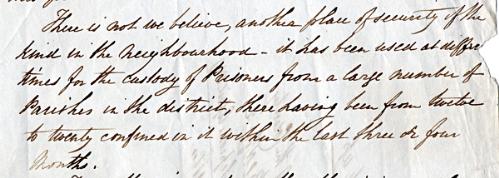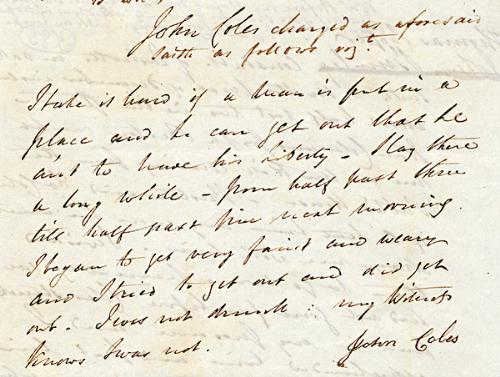Harrold Odell Paths to Crime Walk stop 5 The Lock Up
The Lock-Up, Harrold

Harrold Lock Up in 1906 [ref.Z1130/54/23]
Careless Talk
In 1824 the manor court granted four square yards on Harrold Green to the vicar and churchwardens of the parish to build a "cage" for the use of the village. Lock-ups of this type were used to hold prisoners until they could be brought in front of the magistrates and as a place to put drunks until they sobered up. In 1849 the parish of Harrold wrote to the County Magistrates asking them either to buy the lock-up for the county or to contribute to its upkeep through payment of rent. The village argued that while it had been constructed and maintained at their expense, it was being used by many other villages:

"There is not, we believe, another place of security of the kind in the neighbourhood. It has been used at different times for the custody of Prisoners from a large number of Parishes in the district, there having been from twelve to twenty confined in it within the last three or four months."
The Quarter Sessions agreed that rent should be paid, but that "in other respects the application be not acceded to". By the end of the nineteenth century the lock-up was no longer being used for its intended purpose, and in 1892 was being used for the storage of lamps and oil.
The depositions for a number of Quarter Sessions cases include conversations between prisoners overheard by a policeman listening outside their cell. In 1850 Jonathan Barker, a chimney sweep from Olney, was in the Harrold lock-up on suspicion of stealing two iron shovels. PC Joseph Neal overheard Barker tell his "boy" Henry Hinde (or Hine) to tell the magistrates that he had taken the shovels. Young Henry refused. Fortunately for Barker, it seems there was some doubt as to who was the culprit and he was acquitted. Hinde's subsequent career was quite varied, and did not include chimneys. In the 1851 census he was 16 years old, living with Barker and his family, and employed as a farm labourer. In 1861 he was serving as a private in the militia at Chipping Wycombe (Bucks), and by 1871 he was married, back in Olney and a shoemaker.
Apparently not all lock-ups were as secure as the one in Harrold. In 1837 John Coles was arrested following a fight in Eastcotts and managed to escape from the parish cage. The parish constable described how when he went to the cage in the morning there was a hole in the roof over the door and Coles had gone, leaving ten shillings worth of damage. Coles justified his escape by saying that if the place was not secure it was reasonable for him to get out.

"I take it hard if a man is put in a place and he can get out that he aint to have his liberty. I lay there a long while – from half past three till half past five next morning. I began to get very faint and weary and I tried to get out and did get out."
The magistrates took a different view and sentenced him to two weeks imprisonment.
References: X192/11; QSR1849/2/2/2; QSR1850/4/5/1; QSR1837/1/5/33